 |
||
|
||
| ||
Video systemThe greatest event of the month is new video cards on the GeForce Titanium from NVIDIA and Radeon 7500/8500 from ATi. The announcement of the NVIDIA Geforce3 Ti500, Geforce3 Ti200 and GeForce2 Titanium chips was followed by snowballing video cards on these chips from all partners of NVIDIA. 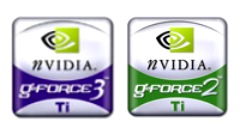 ASUS, ELSA and InnoVISION were the first to launch cards on all chips of the Titanium series. 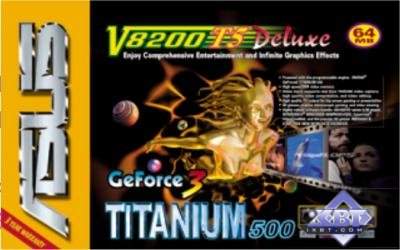 In general, the majority of the card makers develop two or three models, though MSI, for example, has released 7 versions which differ mainly in outputs (VGA/DVI/TB) or accessories (some, thus, come with stereo glasses). Let me outline differences of the Titanium lines from different manufacturers:
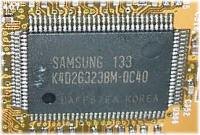 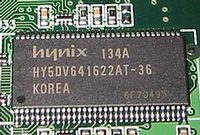 Certainly, there are some overclocked cards; for example, due to a unique cooling system the GeForce3 Ti500 from Gainward has a 260 MHz core and 290 MHz memory, which is 20 MHz and 40 MHz higher than the recommended by NVIDIA. 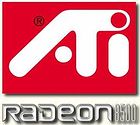 There are also a lot of Radeon 8500 cards appeared on the market. They are created by ATi and its numerous partners: CP Technology, DFI, Ennyah Technologies, Gigabyte, Jetway, Joytech, Power Magic Multimedia, Raising Rich, Sapphire Developments, Shuttle Inc, Super Grace Electronics, Wistron and Yuan Yuan. 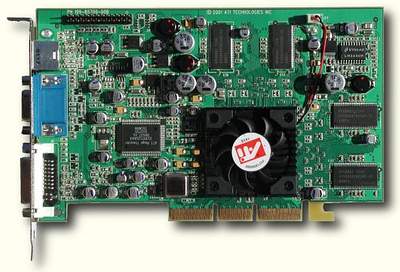 However, not everything went off smoothly: despite the price drop from $399 to $299 and a raise of the core clock speed up to 275 MHz (and not to 250 MHz as it had been promised), the market got in a mess with supplies of the cards from ATi and its partners. The retail Radeon 8500 from ATi entered the market working at 275 MHz/550 MHz (core/memory), while 250/500 MHz version are supplied by OEM manufacturers mainly to PC assemblers. And only by the end of the month ATi cleared up the things by releasing Radeon 8500LE. It runs at 250 MHz and is delivered to the ATi's partners; the company itself is not going to produce Radeon 8500LE cards. Besides, ATi launched Radeon 7000 and Radeon 7200 chips which are, in fact, re-marked Radeon and Radeon VE. At its site the company explains that there is no any difference between these categories and the new 7000/7200 card will start coming to distributors as soon as the chips with the old marks are over. At last, there is no difference in the drivers for the Radeon/Radeon 7200 and Radeon VE/Radeon 7000, and new drivers will work both with the new and the old chips. At MPF 2001 ATi demonstrated its System-on-Chip (SoC) ATi XILLEON 220. The ATi XILLEON 220 combines a processor, a graphics core, video and audio interfaces and is designed for TV consoles and digital TV sets of the latest generation. The chips works at 300 MHz and has a dual-monitor support. Besides, it is able to operate under Linux, Microsoft Windows CE and VxWorks. There is no news from STMicroelectronics - the Kyro II Ultra chip, or STG4800, is still under development and will be released by the year-end. The KYRO III is also in delay: the chip will probably be launched before the year-end but the video cards will appear only in the Q1 2002. In the near future ST Microelectronics is going to demonstrate an altered design of Kyro II based cards. The company will release a version with a video coder Focus FS450 from Focus Enhancements which supports Y-notch and C-bandpass filters to reduce artifacts in inexpensive TV sets; the chip also supports independent scaling on X and Y axes so that possibilities of TV sets with 16:9 side ratio could be used entirely; the special hardware means provide increased readability for small fonts, including hieroglyphs. The new design of the Kyro II + Focus FS450 cards will be finished by the year-end. PDAThe announcement of the Microsoft Pocket PC 2002 operating system was followed by releases of new pocket PCs. As Microsoft decided to support only the ARM processor's architecture promoted by Intel, in this sector PDA makers started to give up alternative processors Hitachi SH-3 and MIPS, and performance characteristics of the new models based on the new platform - mobile Wintel, became much closer. A 206 MHz processor SA-1110 from Intel, a 320X240 color display, 32 or 64 MBytes memory, CompactFlash or Secure Digital slots are the basic characteristics of this PDA family. The Jornada 565 and 568 from Hewlett-Packard and iPaq H3800/Í3700 from Compaq announced in September were supplemented with:
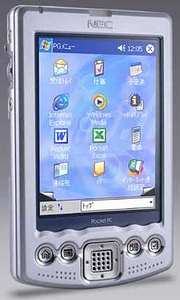 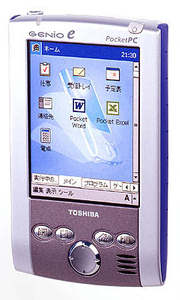 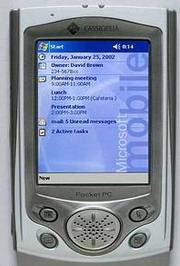 Fujitsu is also going to enrich this list soon. Sharp decided to refuse the Microsoft Pocket PC 2002; in the Q1 next year they are going to demonstrate the RZ-A150 (64 MBytes memory, 206 MHz Intel SA-1110 processor, 320X240 color display, CompactFlash and Secure Digital slots, handwritten and key-pad text input) on the Linux platform. 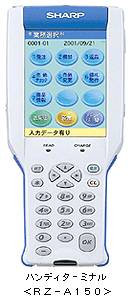 Another non-standard StrongArm new product is Samsung I-TODO which, apart from PDA functions, has a built-in CDMA phone, a slot for SD flash cards and a USB port. 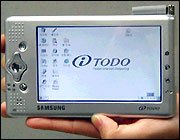 The I-TODO works under the Windows CE 3.0 and has a 5"(!) 480 X 640 color LCD display. It is expected that a special digital camera and a Radio LAN module will be produced as additional units. The number of companies offering different attachments for PDAs (wireless modems, adapters, mobile consoles, digital receivers etc.) keeps growing faster and faster, as well as the number of companies developing applications for the new platform. In October Palm and Handspring made attempts to increase sales of their PDAs, first, by reducing their prices: the inexpensive Palm m100 is now available at $99 and the m105 can be found at $149; however, the middle-class Palm m125 costs $250, as before. On the contrary, Handspring cut the price of the expensive Visor Prism (with a color display) by $100 to $299. Besides, they have announced new models - Treo k180 and Treo g180 which combine functions of a pocket organizer, a cell phone and a Web browser. 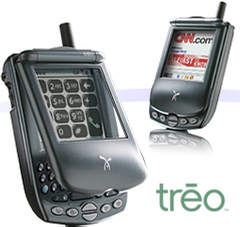 The Treo k180 is equipped with a miniature key-pad, while the Treo g180 supports text recognition. Both models work under the Palm OS and will be available in the beginning of 2002. The estimated price is $399 with activation of the GSM service. The Treo versions with a color screen will be released probably in the middle of 2002 at $599. 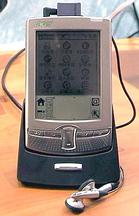 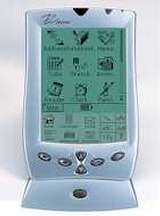 In October two more Palm-like PDAs were launched - Acer s10 (Palm OS 4.1, a 160X160 display, a 33 MHz processor Motorola VZ Dragonball, 16 MBytes RAM, 8 MBytes flash memory, a MemoryStick slot, USB, an MP3 player, at around $375) and EZnow MS-2010 from MSI (a 33 MHz processor Motorola Dragonball, 2 MBytes memory, RS232 or USB). But the prospects are vague: the first is announced only for the Chinese market, and for the second one no terms of release are known yet. 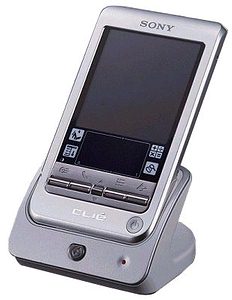 Sony has shown its a bit strange model - Clie PEG-T415. This PDA works under the Palm OS 4.1, has a monochrome 320 X 320 screen, 8 MBytes memory, a MemoryStick slot and can be used as a remote control for home equipment - TV, VCR, audio systems etc. from more than 20 companies. 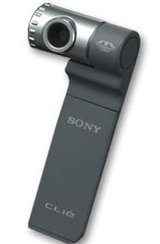 In addition, Sony introduced a PEGA-MSC1 Memory Stick Camera Module which can be used together with CLIE T415, N760C and N610C models and allows shooting at 320 x 240 and 160 x 120. No additional interfaces are required: the camera should be just inserted into a slot for MemoryStick flash cards. Notebooks, Web-tabletsThe last month notebooks makers announced quite a lot of models on Intel's chipsets. Besides, the market acquired so long-awaited i830M and i830MG chipsets (up to 1 GBytes PC133 SDRAM, integrated graphics). As a rule, new models have a more efficient processor, a larger memory, a larger hard disc, a DVD drive and wireless interfaces. A lot of notebooks come with the preinstalled Windows XP. Thus, the Sony's VAIO GR-505 (PCG-GR9E) has a 15" TFT LCD panel with a resolution up to 1600 X 1200 (UXGA), a 1.2 GHz Pentium III-M processor (Tualatin 512 KBytes cache L2), an Intel 830MP chipset, an ATI MOBILITY RADEON-D video card (16 MBytes), 256 - 512 MBytes OS, a 40 GBytes hard drive, 8/8/4/24 DVD/CD-RW drive, 2 Type 2 PC slots, 3 USB ports, IEEE 1394, a 100Base-TX Ethernet network interface and a V.90 modem; this model works under the Windows XP Home Edition.  Despite huge dimensions and weight (3.3 kg) this model will be definitely in requisition. Dell introduced a line of Mobile Precision Workstation M40 products with graphic solutions from NVIDIA - Quadro2 Go.  The system has Mobile Pentium III-M up to 1.2 GHz, up to 512 MBytes of PC133 SDRAM, up to 48 GBytes for a 5400 rpm ATA100 hard drive, a 15" TFT LCD UXGA panel (1600 x 1200) and a 6x/4x DVD/CD-RW drive. Installation of the NVIDIA Quadro2 Go provides for usage of high-level graphics applications such as Maya, AutoCAD, 3D Studio Mac and SoftImage 3D. Another interesting model which appeared the last month is an ultra-thin and ultra-light PC-UM10 from Sharp. 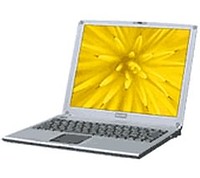 Being only 16.6 mm wide, the notebook is equipped with a 600 MHz ULV Intel Pentium III, 128 MBytes SDRAM, a 20 GBytes hard drive, a 12.1" XGA (1024 x 768) matrix, an ATI Rage Mobility-M (4 MBytes) video adapter and a wide set of peripherals (a PCMCIA 2.1 Card Type II slot, a USB port, a LAN 100Base-TX/10Base-T controller and a V.90 modem). As the AMD's roadmap includes no mobile processors new models on the mobile Athlons are not announced either. On the contrary, Transmeta informed about models on the new processor but they failed to appear on the shelves because of the problems with mass production of the Crusoe 5800. 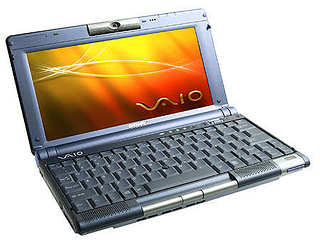 A typical model of this class is VAIO C1MV Picturebook from Sony: a 733 MHz processor TM5800, a 8.95" UWSXGA (1280 x 600) TFT LCD display, a 20 GBytes hard disc, 128 MBytes DDR SDRAM, an ATI Radeon-M video adapter with 8 MBytes memory, a V.90 modem, an IEEE 1394 port, a PC Card TypeII (PCMCIA) slot, a slot for Memory Stick cards, a built-in video camera and an external port (10/100 Ethernet, USB, VGA-out, audio-in and audio-out). Now the Picturebook C1MV with the preinstalled Windows XP is expected not earlier than the middle of November. In October Apple announced a line of its notebooks Titanium PowerBook G4 consisting of 667 MHz and 500 MHz processors PowerPC 7440 with a 133 MHz system bus, a new graphics adapter ATI Mobility Radeon AGP 4X (16 MBytes) and an integrated LAN adapter 10/100/1000BASE-T Ethernet. 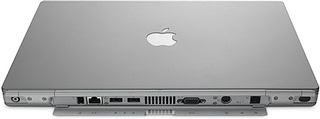 The further development of the PowerBook G4 Titanium line will take place at MacWorld Tokyo Display next year where Apple is going to introduce notebooks of the new generation on the PowerPC 7460 processor based on the 0.13 micron process and SOI. The sphere of Internet tablets is not promising so far. Sony, Netpliance and 3Com which took out of production their tablets were followed by Gateway which withdrew its Connected Touch Pad. The matter is that sales volumes are not huge and the cost is almost equal to low-end computers. 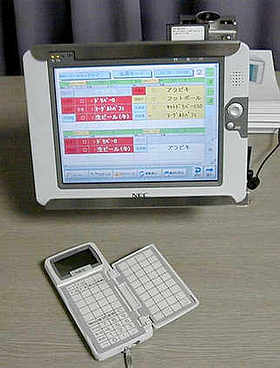 NEC, however, launched a business-class tablet Touch@i on the 266 MHz processor Geode SC3200 from National Semiconductor with a 10.4" 800 X 600 TFT LCD panel. Due to a PC Card Type II slot, USB and RS-232C interfaces and a keyboard and mouse support such a business model can be easily turned into an elegant POS terminal. Digital photographyThe most considerable event of the month is filing by Polaroid of Chapter 11 bankruptcy protection. At present Polaroid has about $1 billion on the credit side ($600,000,000 belong to bondholders and some $350,000,000 are in the banks of two groups controlling the company). Of course, the facilities, patents and the trade mark will be purchased, but it will be a different Polaroid... Among interesting new-comers there is a 3-Mpixel Olympus C-3100Z of a middle price range. 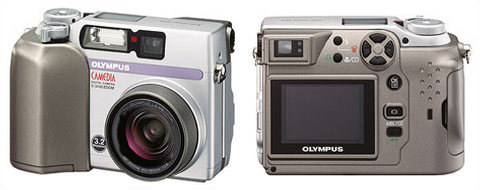 The C-3100Z is equipped with a 1/1.8" CCD 3.34Mpixel matrix, a slot for SmartMedia cards (4 - 128 MBytes), an optical system with a 3x zoom and a 1.8" TFT LCD display.  Hewlett Packard announced three new cameras, though they are not extraordinary: a 2.31Mpixel Photosmart 318 with a 2X digital zoom and a 1.75" LCD ($199), similar to the Photosmart 612, but for a 2X optical zoom ($299) and a 3.3Mpixel Photosmart 715 with a 3x optical zoom ($499). Casio has also two new models: a 2Mpixel QV-2100 is the first model to support SD/MMC flash cards. 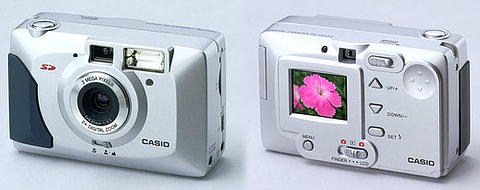 Casio, which is known to be fond of the CF format, has decided to take the first step to other formats. 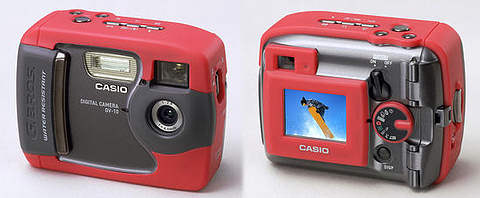 The other camera is 1.3Mpixel G.BROS GV-10 which is water-proof and which has a unique design. 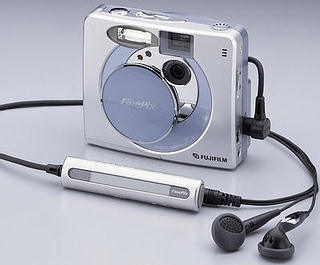 Fuji Photo Film keeps up to date. The 2.2Mpixel FinePix 50i with SuperCCD and the Finepix 30i (with a usual CCD and a simpler optical system) are unsophisticated digital cameras with a digital MP3 player are meant for young people. MultimediaThe October was scarce for new multimedia models, in particular for new audio cards. Creative released only one new PCI card Sound Blaster 4.1 Digital which is the best solution for 4.1 acoustic sets like Creative FourPointSurround FPS1600. 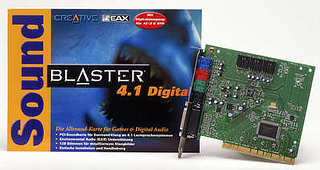 The Digital 4.1 is an ordinary budget solution on the CT5880 processor. The sound codec is the same as in the Live! 5.1 - 4-channel Sigmatel STAC9708T, and the EAX technology is supported only by two speakers. Hercules introduced the v3.01 drivers for Win9x, Windows ME, Windows 2000 and Windows XP the best asset of which is 5.1 and 6.1 channel modes support in games. It is really a great advantage for owners of the GameTheatre XP card. 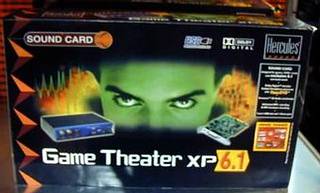 Besides, the Game Theater XP, when used together with the CyberLink PowerDVD 6.1 Pro, can reproduce Dolby Digital EX sound in the 6.1 channel mode. Moreover, it has Small Speaker mode and hardware acceleration of MP3 reproduction for 4- and 5.1 speaker configurations. In addition to the 5.1 system Inspire 5.1 5300 announced in September Creative introduced Inspire 5.1 Digital 5700 which consists of a decoder/amplifier unit, a 30W (RMS) subwoofer Creative SLAM (Symmetrically Loaded Acoustic Module), a 21W (RMS) central speaker , 4 satellites of 7 W (RMS) each and a remote control. 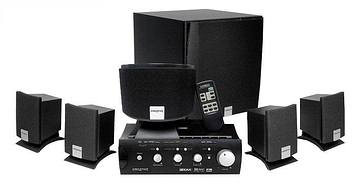 This system is compatible with any 24 bit/96 kHz cards and equipped with analog stereo and digital inputs, including an optical one. The Inspire 5.1 Digital 5700 differs from the Inspire 5.1 5300 in more powerful subwoofer and satellites and in DTS support. Besides, Creative is going to launch a 5.1 acoustic set Cambridge SoundWorks MegaWorks 510D with the frequency range of 32 Hz - 20 kHz and total power of 450 W RMS (150 W RMS for a subwoofer and 60 W RMS for each satellite). 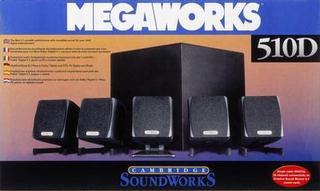 Input variants: 6-channel analog, RCA, one stereo mini jack, digital-in. Another model from Creative which hit the streets last month is a stationary DVD player Cambridge SoundWorks DVD-3500 with an acoustic set which is probably still under development. 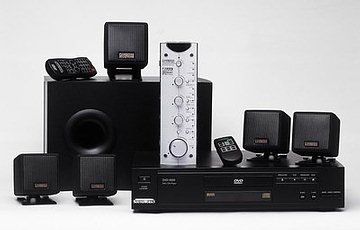 By the end of the month we were informed about a developing 5.1 system Altec Lansing ADA-995 certified for the THX standard. Approximate characteristics of the system are: power of each of 5 satellites is 20 W, the subwoofer (2 6.5" speakers) is of 100 W. The system works in the range of 38 Hz - 20kHz, has an analog-in and Dolby Multimedia Surround Sound support. PeripheralsEarly in October Xerox declared delivering 4 factories located in Asia, Canada, Mexico and South America to Singaporean Flextronics in order to decrease production costs and transfer to OEM deliveries from Flextronics which will pay approximately $200 million a year to Xerox for the plants. It turned out that Flextronics is keeping an eye on other facilities of Xerox - a PCB factory in California and an after-sales service network in the New York State. Besides, the rumor has it that the European facilities of Xerox will be delivered to the Flextronics' European department - a Dutch company Venray. Recently Flextronics acquired a printer plant of Hewlett Packard in Singapore and production facilities of Alcatel in France... This month Canon announced 4 new bubble-jet printers. The business-class S6300 ($438) can print out 17 ppm at the expense of the Fast Gear System. 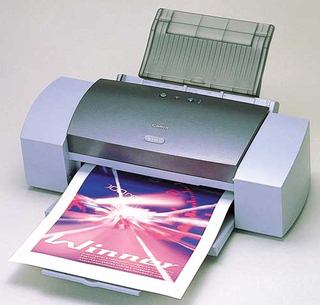 The Precision Paper Feed mechanism provides continuous feeding of paper of any type. The S6300 format is A3+. The S100SP ($77) and S300 ($148) models are intended both for home and office. The S300 uses black ink of increased brightness which keeps its qualities during 25 years. To save time and ink there is a Single Key Button: to stop printing you should press it just once. The most economical model is S400SP ($126) which supports Think Tanks System and Super Economy Mode to minimize ink consumption. Lexmark introduced color printers C750 and C910 and monochrome laser ones E320 and E322, as well as a multifunctional device Lexmark X820e. 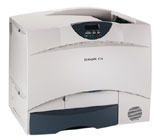 The Lexmark C750 ($2999) is designed for workgroups and can print out 20 ppm both in monochrome and color modes with a resolution up to 1200 X 1200 dpi. Soon the company is going to release C750n ($3399) and C750dn ($4899) which will feature additional network possibilities and increased feeders. The Lexmark C910 can use paper of 275 X 425 mm, the printing speed is up to 28 ppm in monochrome and color modes with a resolution up to 2400 dpi.  On the analogy of the previous models the C910n and C910dn to be released soon will have network functions and increased feeders. The speed of the new monochrome laser models Lexmark E320 ($299) and E322 ($399) is 16 ppm; the second model will also have a network version - E322n ($599). The X820e ($12999) is a multifunctional MFP device with a color touch screen and network features. It is meant for a corporate network. The USB 2.0 model Color Inkjet Printer cp1160 from Hewlett-Packard introduced the last month was supplemented with two families of color bubblejet printers and two new print-servers. The HP Color Inkjet Printer cp1700/cp1700ps ($499/$599) models are designed for large-format (325 X 475 mm) printing on a network. 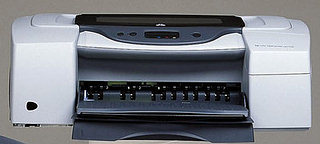 The cp1700d supports two-sided printing. The cp1700ps supports Adobe PostScript 3 and can work under different versions of Windows, MacOS and Linux. The HP Business Inkjet Printer 2600 ($999) is meant for network mode (for example, together with the HP Jetdirect print-server), and is equipped with a Web-server for remote printer control from a standard browser with the HP Web Jetadmin 6.5 program. 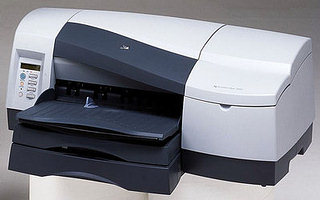 The paper format is up to 325 X 475 mm, two-sided printing is supported, while the 2600dn ($1399) has a feeder for two-sided printing and an EIO network card. The HP Jetdirect 200m and 250m print-servers ($199/$259) provide a separate access to cp1160 and cp1700 printers and are compatible with other models equipped with LIO network slots. The HP Wireless Print Server wp110 ($299) is a print-server which works with wireless networks of the 802.11b standard. Seiko Instruments USA announced a miniature thermal printer DPU-H245. It supports wireless printing at the expense of a 2.4 GHz module. The device has a resolution up to 384 dpi and a speed up to 50 mm/s for 2" paper. The distance range in a wireless mode is 150 m. Umax released an ultra-thin (3 cm high) scanner AstraSlim 600 with the USB interface. 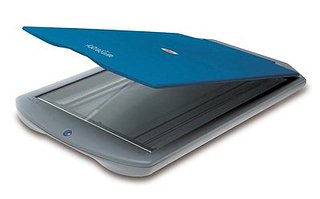 The optical resolution of the AstraSlim 600 is 600 X 1200 dpi at 48bit color, and a possible interpolation is up to 9600 x 9600 dpi. In October Wacom launched graphics tablets FAVO. 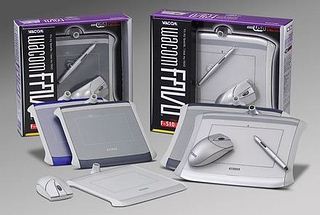 The F-410 ($100) has an A6 input area while the
F510 ($150) has a B6 one. Both models have a USB interface and come
with a pen and a mouse. Both input devices are wireless, and the
pen has 512 levels of pressure.
Write a comment below. No registration needed!
|
Platform · Video · Multimedia · Mobile · Other || About us & Privacy policy · Twitter · Facebook Copyright © Byrds Research & Publishing, Ltd., 1997–2011. All rights reserved. |